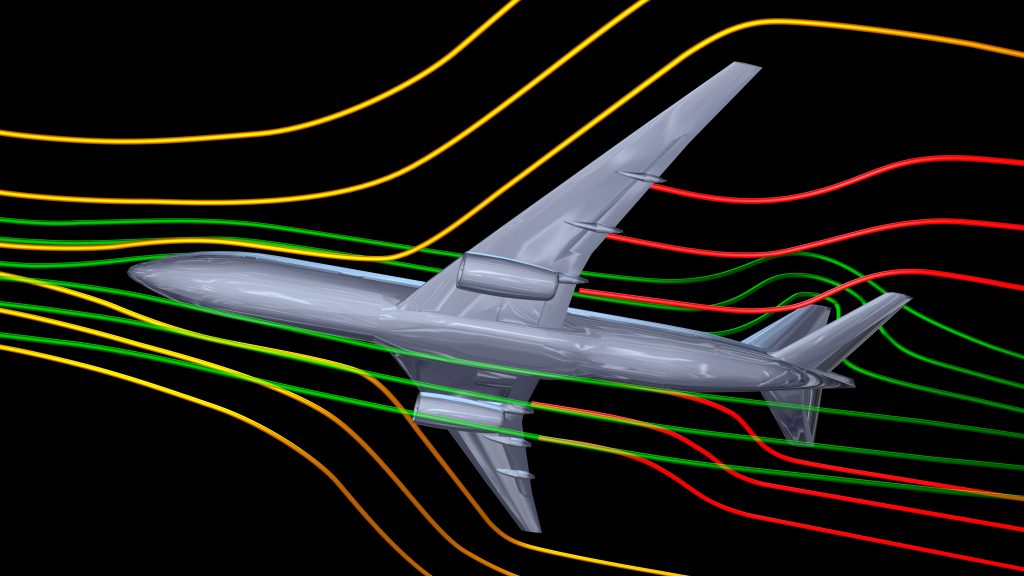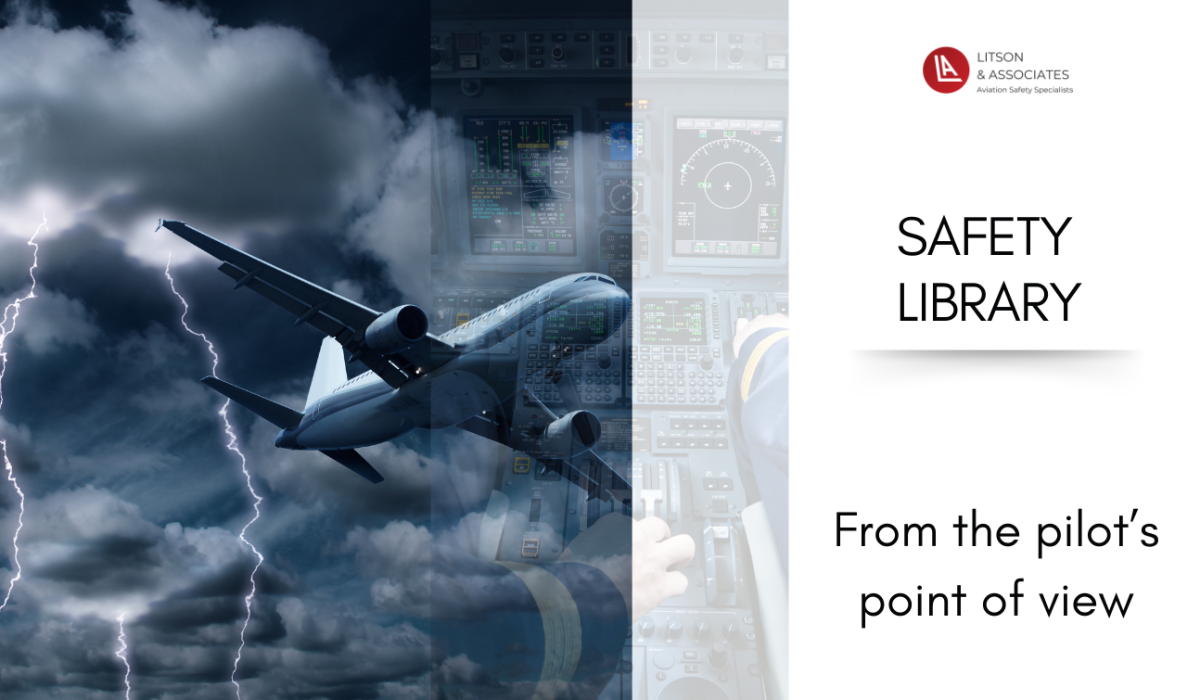Please fasten your seat belt
Litson & Associates' safety specialists share the pilot's point of view on turbulence
authored by Allan Williamson assisted by Yovesh Naidoo
Table of Contents
Introduction
The proliferation of recording devices and social media has brought public attention to the chaos which ensues in aircraft cabin interiors after severe turbulence encounters, with surreal images of a mess of food, liquids, catering equipment and personal belongings; damage to ceilings and luggage bins; and dislodged oxygen masks. It is surprisingly common for passengers and crew to be injured in turbulence encounters. This was highlighted recently on 21 May 2024 when Singapore Airlines Flight SQ321, a Boeing 777 flying from London Heathrow to Singapore, encountered severe turbulence northwest of Bangkok. The unfortunate event made headlines as one of the injured passengers subsequently passed away. Another notably tragic instance of death due to turbulence occurred on 28 December 1997. A Boeing 747 flying from Narita, Japan to Honolulu, Hawaii, flew into clear air turbulence (CAT) causing 1 fatal, 18 serious and 171 minor injuries.
A quick search on the aviation website “The Aviation Herald” shows at least 23 reported turbulence encounters since June 2023 causing well over 200 injuries. L&A’s aircraft incident and accident system eVENT-S, has recorded 22 reported incidents of turbulence in only the first six months of 2024.
Between 2014 and 2018 Airbus received 240 reports of severe turbulence resulting in injuries to passengers and crew. Most injuries in the cabin happened to passengers or crew members who were not seated with their seatbelts fastened during the turbulence encounter. Cabin crews are more exposed to the risk of injury in sudden turbulence because they are often standing during service. The United States National Transportation Safety Board (NTSB) found that between 2009 and 2018, turbulence-related accidents accounted for more than a third of all airline accidents. Most of these accidents resulted in one or more serious injuries but no substantial aircraft damage. Minor aircraft damage involved cabin components such as seats, ceiling panels, overhead bins, and passenger service units. A study by the Japanese Transport Safety Board (JTSB) in 2015 found that injuries were most prevalent in the aft section of the aircraft, with flight attendants most at risk. The most common injuries were fractures followed by concussions, bruises and burns. The direct causes of the injuries were heads hitting ceilings, contact with seats, other persons and the floor, and burns suffered from hot drinks.

What is turbulence?
Every general aviation pilot loves to fly in the early morning when the air is beautifully smooth and calm with no annoying bumps. The atmosphere is however dynamic, and weather is the result of the atmosphere’s response to unequal rates of radiational heating and cooling. Turbulence arises from variations in wind velocities, much like the eddy currents in flowing water or a swirling bathtub. Although most weather phenomena occur in the troposphere, which extends from the earth’s surface to a height of about 10 km, severe turbulence in the stratosphere above can be caused by the convective overshoot of thunderstorms from below.
For ease of description, the intensity of turbulence is classified according to its impact on the aircraft’s trajectory and the effects felt in the cabin:
- Light turbulence momentarily causes slight, rapid, and rhythmic bumpiness without noticeable changes in aircraft altitude or attitude. Liquids shake but do not splash out of cups. Trolleys can still be manoeuvred with little difficulty. Passengers may intermittently feel a slight strain against their seat belts.
- Moderate turbulence causes rapid bumps or jolts. Liquids splash out of cups. Trolleys are difficult to manoeuvre. It’s difficult to walk in the cabin or to stand without holding onto something. Passengers feel definite strain against their seat belts.
- Severe turbulence causes large abrupt changes in aircraft altitude and attitude with large variations in airspeed. Items fall or lift off the floor. Loose items are tossed about the cabin. It is impossible to walk. Passengers are forced violently against their seat belts.
Types of turbulence:
Thunderstorms
Convective turbulence is the turbulent vertical motions that result from convective air currents; in effect bubbles of air which warm and rise, then cool and sink. This causes the bumpiness at lower altitudes that our general aviation pilot doesn’t enjoy. When moisture is present, together with a convective or other lifting force, cumulonimbus clouds (CB) can build up into thunderstorms too tall to fly over, too dangerous to fly through or under, and difficult to circumnavigate. There are as many as 40,000 thunderstorm occurrences each day worldwide. Thunderstorms are associated with lightning, thunder, wind gusts, heavy rain, sometimes hail, and extreme turbulence. They can form a band or squall line that can extend laterally for hundreds of kilometers.
Clear Air Turbulence (CAT)
While thunderstorms are visible, Clear Air Turbulence or “CAT” is not. CAT is associated with jet streams, which are relatively narrow bands of strong wind found in the vicinity of the tropopause (the boundary region between the troposphere and the stratosphere). They can be compared to rivers of air, and the turbulence is caused by the difference in velocity between the core of the jet stream and the surrounding air. It’s especially troublesome because it is often encountered unexpectedly and frequently without visual clues and can cause violent buffeting.
Mountain Waves
As the name suggests, mountain waves are the result of windy conditions in mountainous areas which, if the wind is sufficiently strong with a stable surrounding atmosphere, can cause a wave to develop which can extend up to 100 Nm downwind of the mountain range and all the way up to the cruising altitude of airliners. They are predictable in certain mountainous areas and are sometimes indicated by the formation of lenticular clouds downwind of the mountain range.
Wake Vortices
All aircraft in flight generate wake vortices. The differential pressure above and below a wing in flight causes a roll-up of the airflow aft of the wing which trails behind the aircraft in a pair of counter-rotating vortices. These vortices pose a potential hazard to the safe flight of aircraft crossing or operating below the trajectory of the generating aeroplane. On 7 January 2017, the wake turbulence from an Airbus A380 caused a bizjet passing 1000 feet below to lose control, roll three times in midair and drop 10,000 feet!
.

The Pilot's persepective:
Weather Forecasts
To a certain extent, the location and extent of thunderstorm development, mountain waves and jet streams are predictable. Pilots can use weather forecasts to plan flight levels, fuel uplifts, and to anticipate areas of possible turbulence. They can brief their cabin crew accordingly.
Pilot and ATC Reports
Pilot observations of turbulence (PIREPs) are most often verbally communicated to air traffic controllers. These reports are subjective, as the assessment of the turbulence’s intensity and duration is that of the pilot. Some airlines and third parties have developed turbulence information-sharing platforms to share objective data and provide real-time turbulence information to flight crews. Such objective data is derived from aircraft sensors, or the accelerations recorded inflight on the pilots’ electronic devices. The use of these platforms is however not widespread. It has been proposed to add to ADS-B, a datalink system for broadcasting and receiving data from aircraft, a capability for continuous, automated broadcast of weather-related data monitored by aircraft sensors.
Onboard Weather Radar
Weather radar detects the presence of water droplets within the scanned area. The echo returns vary in intensity as a function of droplet size, composition and quantity. Although many of the limitations of older systems have been overcome with modern software and technological advances, knowing the capabilities and limitations of the system installed on the aircraft and being familiar with the techniques for using the weather radar is key to the timely detection and avoidance of convective turbulence. Many modern systems have a turbulence or “TURB” mode, based on the Doppler effect, which displays regions of extreme relative precipitation movement within the cloud as a proxy for wind shears.
Storm cells should be avoided by 20NM laterally and preferably on the upwind side. Turbulence can extend well above the visible top of a cumulonimbus and if overflight cannot be avoided, a vertical margin of at least 5000 feet should be applied. Of course, it is not always possible to apply these margins, particularly when penetrating a “wall” of cells, or when climbing out of or descending towards an airfield. This is where the knowledge, skill and good sense of the flight deck crew comes into play.
Aircraft Handling
Every aircraft manufacturer has published recommended turbulence penetration procedures. The seatbelt signs should be turned ON and the cabin crew notified. A lower flight level enables the flight crew to increase the aircraft’s margins before buffet onset. Shoulder harnesses should be fastened, and loose objects stowed. The aircraft should be slowed to the published turbulence penetration speed. The manufacturer will have recommendations regarding the use of autopilot and auto-thrust and flying techniques, depending on the level of sophistication of the aircraft and its systems. It is important not to cause unnecessary accelerations by overcorrecting variations in aircraft flight path and speeds.
Communication with Cabin Crew
The pre-flight briefing presents the ideal opportunity for flight and cabin crews to discuss the potential for turbulence, with personal safety prioritized and the use of standard phraseology and SOPs emphasised.
Turbulence in flight can be anticipated, or it may be unexpected. For a start and obvious reasons, it’s important to keep a tidy galley and cabin.
When approaching an anticipated area of turbulence, the flight crew should advise the cabin crew on the preparation time available and the level and expected duration of the turbulence. An announcement should be made to the passengers requesting them to return to their seats and fasten their seatbelts. The announcement carries more weight if it comes from the flight deck and if it is in advance of the illumination of the seat belt sign. The cabin crew would need to prioritize their duties based on the available time; suspending in-flight services, stowing and securing large items, dealing with hot liquids, securing the cabin and galleys, and ensuring that the lavatories are unoccupied. Once they have returned to their stations and fastened their seatbelts, they should advise the flight crew that the cabin is secured.
When encountering an area of unexpected turbulence, the flight crew must switch the seatbelt signs ON and make an announcement on the public address system requesting passengers and crew to take up their seats and fasten their seatbelts immediately. In cases of sudden severe turbulence, a cabin crew member’s personal safety comes first. Take the nearest available seat and fasten the seat belt securely.

Conclusion:
The flight crew needs to inform the cabin crew once the aircraft is clear of severe turbulence so that the cabin crew can check for passenger injuries, give first aid, if necessary, calm and reassure the passengers and check for any cabin damage. The purser should then provide a cabin status report to the flight crew detailing the number and extent of any injuries, and any cabin damage.
Any severe turbulence encounter must be reported to maintenance so that the maintenance crew are alerted to perform the necessary inspections of the aircraft before the next flight.
Your safety lies in your hands...
Wearing a seat belt reduces the risk of serious injury for all aircraft occupants during turbulence-related accidents. However, there are authorised movements and activities within the passenger cabin during flight, and unexpected turbulence encounters can occur.
The first announcement to passengers should include an invitation to passengers to keep seat belts fastened even when the seat belt sign is switched off. This minimises the risk of passenger injury in the event of a turbulence encounter en route. Announcements by pilots appear to carry more weight than flight attendant announcements. Communication between flight crew and cabin crew is key to effectively managing the risk.
About our authors
Allan Williamson has logged more than 20,000 pilot flying hours in a career spanning over 40 years. He has flown helicopters, light aircraft and airliners, including Boeing and Airbus
Yovesh Naidoo holds a pilot’s license and manages L&A’s eSCHED-S, eFLITE-S, and eVENT-S platforms. Analysing different aspects of airlines based on the risks associated with them, as well as examining various accidents and incidents that occur in the industry.
References:
- https://avherald.com/
- https://skybrary.aero/
- EASA Safety Information Bulletin Number 2017-10R1 dated 02 Sep/2021: En-route Wake Turbulence Encounters
- Airbus Safety First publication #21 dated Jan/2016: Wake Vortices
- Airbus Safety First publication #22 dated Jul/2016: Optimum Use of Weather Radar
- Airbus Safety First publication #29 dated Nov/2019: Managing Severe Turbulence
- NTSB Safety Research Report NTSB/SS-21/01 adopted 10 Aug/2021: Preventing Turbulence-Related Injuries in Air Carrier Operations Conducted Under Title 14 Code of Federal Regulations Part 121
- Japan Transport Safety Board Digest of Aircraft Accident Analyses issued Jan/2015: For Prevention of Accidents due to the Shaking of the Aircraft
- BEA Incidents in Air Transport #5 dated Dec/2006: Wind Gradients and Turbulence
- FAA Advisory Circular # 00-30C dated 22 Mar/2016: Clear Air Turbulence Avoidance
- FAA Aviation Weather Handbook FAA-H-8083-28 dated 2022
